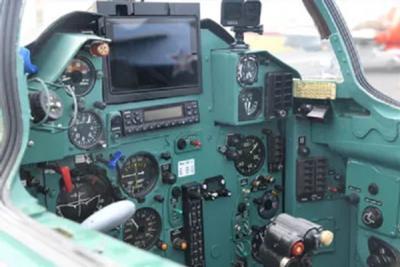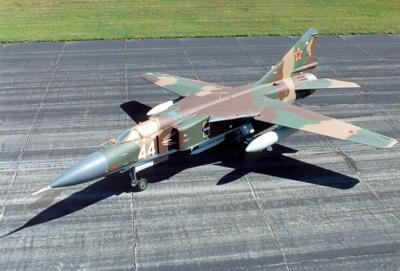Of Sad Stories and Happy Endings
On 13 August 2023, a MiG-23 went down while taking part in the Thunder Over Michigan air-show. Held yearly at Ypsilanti, Michigan’s Willow Run Airport (YIP), Thunder Over Michigan is among the U.S.’s premier air-shows, drawing aircraft from around the wide world.

The accident aircraft, a MiG-23UB built in 1981 and imported from the Czech Republic, had been largely restored by and belonged to Dan “Files” Filer, a U.S. Navy combat veteran who flew A-6 Intruders in the Gulf War.
A number of years ago, Mr. Filer happened upon a MiG-23 up for sale and pursued purchase of such. While seeking out parts for the jet, he discovered 17 additional MiG-23s (in various states of disrepair) for sale, and purchased every one, donating the single-seaters to various air museums.
The Sunday, 13 August mishap, which is rumored to be attributable to engine malfunction or failure, saw Mr. Filer and a second, as-of-yet-unidentified aviator eject from the MiG-23 as it traversed the airspace over Ypsilanti, Michigan’s Willow Run Airport (YIP). The unpiloted jet came almost immediately to ground, impacting a number of unoccupied vehicles in the parking lot of Van Buren Township’s Waverly on the Lake Apartments. By dint of extraordinary good fortune, no ground injuries were reported and Mr. Filer and his companion were rescued from Bellville Lake.
Filer and the individual occupying the accident-aircraft’s aft station—known in official military parlance as a Combat Systems Officer (CSO) and colloquially as a backseater—both ejected successfully from the aircraft and landed safely, albeit soggily, under canopy.
Michigan’s Wayne County Airport Authority set forth: “While it did not appear they [the Mig-23’s occupants] sustained any significant injuries, first-responders transported the pair to a nearby hospital as a precaution.”
Filer and his backseater, after reportedly being fished from Bellville Lake, were precautionarily conveyed to Superior Township’s St. Joseph’s Hospital.
The MiG23, while lumbering and technologically remedial by Western standards, is looked upon by historians as one of the Soviet Union’s more enduring combat aircraft.
Conceived of and built by the alternately famed and infamous—depending on one’s political bent— Mikoyan-Gurevich design bureau, the MiG-23 (NATO designation Flogger) is a third-generation, variable-geometry fighter aircraft powered by a single, 18,000-lbf Khatchaturov R-35-300 afterburning turbojet engine fitted with variable-geometry exhaust nozzles. First flown in 1967 and fielded in 1970, the MiG-23 remained in service with Eastern Bloc nations well into the 1990s. Over its 18-year (1967-1985) production-run, over five-thousand specimens of the MiG-23 were built, thereby distinguishing the machine as history’s most-produced variable-geometry aircraft.
After the fashion of Soviet fighters and interceptors of its day, the MiG-23 was at once blindingly-fast and eminently hazardous to the health of its pilots.

American intelligence germane to the Mig-23 assumed the aircraft was reasonably maneuverable and adhered to its advertised 1,349-knot (Mach 2.35) maximum speed. Testing, however, proved the former assumption incorrect. While the Mig-23’s turning capability was comparable to that of early-model McDonnell-Douglas F-4 Phantoms, newer U.S. fighters—namely the F-15—easily out-turned the Mig-23 in a dogfight. It was further determined that at high angles of attack the MiG-23 was an exceedingly unstable platform, liable to depart controlled-flight violently and with little-to-no warning.
Conversely, the MiG-23’s acceleration was nothing short of tremendous, particularly at low altitudes (below 10,000-feet MSL), where it easily out-accelerated the entirety of the Western world’s fighter inventory. The MiG-23’s speed forgave, to some extent, the aircraft’s poor maneuverability, and defined its role as an interceptor—as opposed to a true fighter-aircraft.
American pilots afforded opportunity to fly the Mig-23 noted with consistency that the jet’s airframe was easily overstressed, that it was unstable in yaw as it passed Mach 1.0, and again when approaching Mach 2.0; and that the narrow placement of the aircraft’s main landing-gear was wont to slip and slide in adverse weather conditions. The MiG-23, broadly speaking, was unpopular with American pilots, who found the machine unacceptably dangerous to operate and bestowed upon it a host of derogatory monikers the likes of Looping Hog—on account of it flew like a pig and one of the few basic fighter maneuvers (BFM) it could reliably perform in a dogfight was a massive inside loop.

According to retired USAF Colonel John “Sax” Saxman, the only other BFM the MiG-23 could manage was the no circle fight—a term denoting two opposing aircraft approaching and passing close by each other. Under such circumstances, the MiG-23, instead of trying to turn one way or the other in pursuit of the enemy aircraft, would speed on ahead until it could rejoin the fight from a different angle.
The MiG-23's idiosyncrasies—deficits and qualities alike—were recognized, also, by Warsaw Pact militaries. Retired USAF Commander Marty Macy, formerly of the service’s 4477th Test and Evaluation Squadron, remarked: “I spent a lot of time in Berlin watching GCI [Ground-Controlled Interception] tapes to verify we were flying the right tactics, and it became clear to me that the East Germans knew exactly what the MiG-23's limitations were. They knew that since it was un-maneuverable, they had to attack from many different directions as fast as possible. It was sophisticated, and they were going to overwhelm us if we ever went up against them. I sat down with some analysts and linguists and listened to what the pilots were saying to their GCI controllers and I actually started to respect them for what they were doing with a very limited asset.”
Despite the large numbers in which it was produced, airworthy Mig-23s are a rarity in the West. Ergo, attendees of EAA AirVenture 2023 were delighted in late-July by the appearance of Mr. Filer’s Flogger—North America’s (then) only flying Mig-23.

Speaking to the subject of the Flogger’s less-than-stellar reputation among fighter aircraft, Mr. Filer asserted at the time: “It didn’t have a great reputation with the U.S. pilots that flew it because they flew the base model. … Soviet guys that I’ve talked to, they love the airplane. And I like the airplane. Would I want to dogfight in it? No.”
During an AirVenture 2023 interview, Mr. Filer stated public reaction to his MiG-23 has consisted of excitement and confusion in equal parts.
“Nobody’s seen it,” Flier averred. “They say, ‘We didn’t know any of these existed.”
Mr. Filer added: “I’ve been flying around my hometown, Longview, Texas, and it was time to display it. They’re just like, ‘We didn’t know there were any of these.’ So we’re excited. It’s been positive. Anybody from the Eastern bloc countries, they all come over. This guy just got a big tattoo of one 30 years ago. And then I have a bunch of Polish ones. This one came from the Czech Republic. I got Polish ones, Bulgarian ones. … They’re so excited that I have this up and flying.”
While the loss of North America’s only flying MiG-23 is unfortunate, the whole of the aviation community, to include the staff of Aero-News Network, is grateful Mr. Flier and his backseater survived the incident without serious injury. Machines, after all, can be rebuilt, and Mr. Filer’s backstory suggests he may yet have a considerable number of Mig-23 components in his possession.
 ANN's Daily Aero-Term (04.26.24): DETRESFA (Distress Phrase)
ANN's Daily Aero-Term (04.26.24): DETRESFA (Distress Phrase) Aero-News: Quote of the Day (04.26.24)
Aero-News: Quote of the Day (04.26.24) ANN's Daily Aero-Term (04.27.24): Direct
ANN's Daily Aero-Term (04.27.24): Direct ANN's Daily Aero-Linx (04.27.24)
ANN's Daily Aero-Linx (04.27.24) Aero-News: Quote of the Day (04.27.24)
Aero-News: Quote of the Day (04.27.24)






